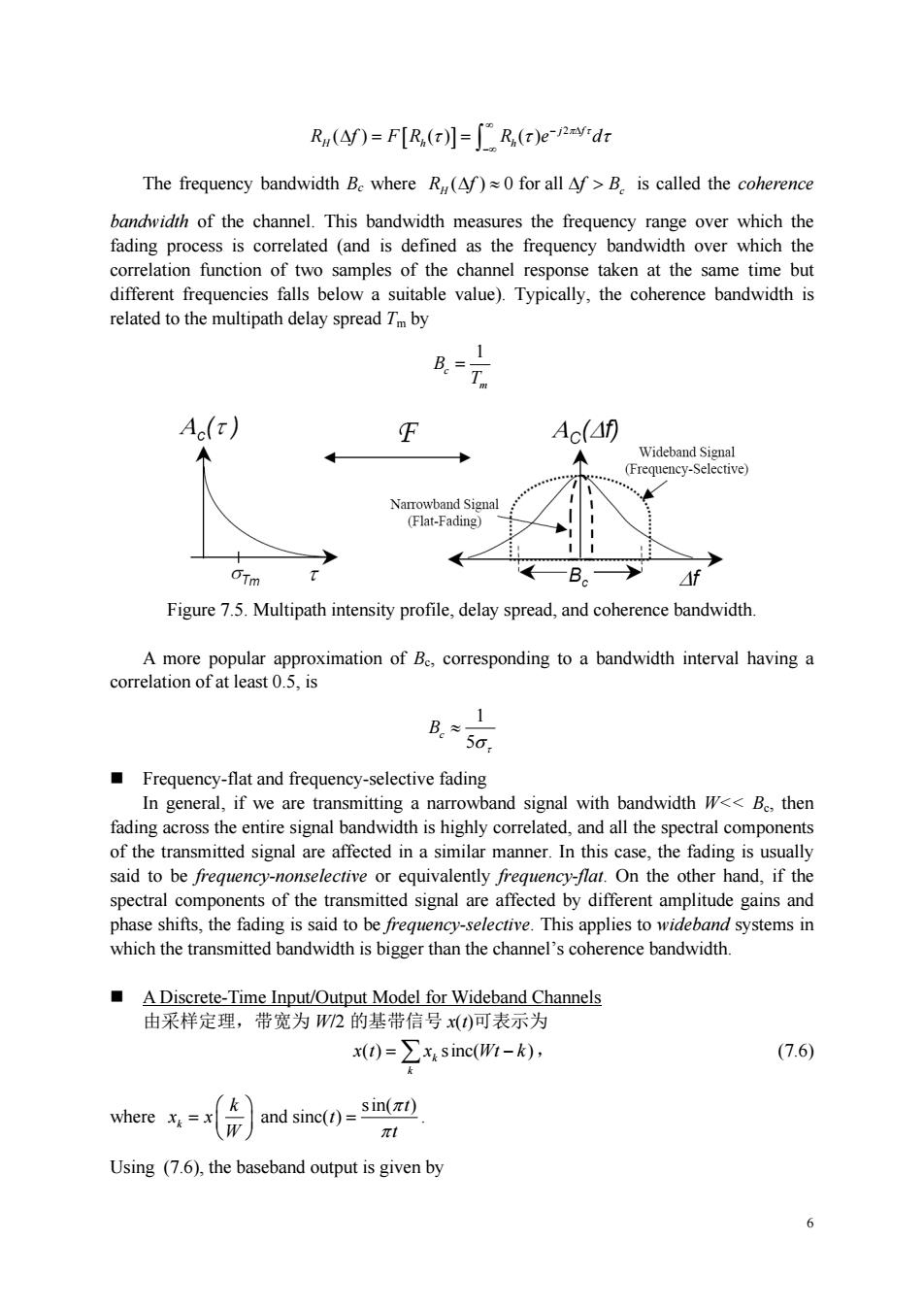
R(f)=F[R,()]=[R(r)e-vidr The frequency bandwidth B.where R(f)0 for all f>B.is called the coherence bandwidth of the channel.This bandwidth measures the frequency range over which the fading process is correlated (and is defined as the frequency bandwidth over which the correlation function of two samples of the channel resp onse taken at the same time but different frequencies falls below a suitable value).Typically,the coherence bandwidth is related to the multipath delay spread 7m by B.= T Ac() Ac(40 A N (Flat-Fading) ← B。1 Figure 7.5.Multipath intensity profile,delay spread,and coherence bandwidth. B50, Frequency-flat and frequency-selective fading In gene eral,if we are a na rowband signal with bandwidth W<<B.then of the transmitted signal are affected in a similar manner.In this case,the fading is usually said to be frequency-nonselective or equivalently frequency-flat.On the other hand,if the spectral components of the transmitted signal are affected by different amplitude gains and hase shifts,the fading is said to be freque ncy-selective.This applies to wideband systems in which the transmitted bandwidth is bigger than the channel's coherence bandwidth A Discrete-Time Input/Output Model for Wideband Channels 由采样定理,带宽为W2的基带信号x()可表示为 x()=∑x4sinc(W所-k), (7.6) where)and sine()i) Using (7.6),the baseband output is given by a
6 2 ( ) () () j f RH hh f FR R e d The frequency bandwidth Bc where ( ) 0 for all RH c f fB is called the coherence bandwidth of the channel. This bandwidth measures the frequency range over which the fading process is correlated (and is defined as the frequency bandwidth over which the correlation function of two samples of the channel response taken at the same time but different frequencies falls below a suitable value). Typically, the coherence bandwidth is related to the multipath delay spread Tm by 1 c m B T Figure 7.5. Multipath intensity profile, delay spread, and coherence bandwidth. A more popular approximation of Bc, corresponding to a bandwidth interval having a correlation of at least 0.5, is 1 5 Bc Frequency-flat and frequency-selective fading In general, if we are transmitting a narrowband signal with bandwidth W<< Bc, then fading across the entire signal bandwidth is highly correlated, and all the spectral components of the transmitted signal are affected in a similar manner. In this case, the fading is usually said to be frequency-nonselective or equivalently frequency-flat. On the other hand, if the spectral components of the transmitted signal are affected by different amplitude gains and phase shifts, the fading is said to be frequency-selective. This applies to wideband systems in which the transmitted bandwidth is bigger than the channel’s coherence bandwidth. A Discrete-Time Input/Output Model for Wideband Channels 由采样定理,带宽为 W/2 的基带信号 x(t)可表示为 ( ) sinc( ) k k x t x Wt k , (7.6) where sin( ) and sinc( ) k k t xx t W t . Using (7.6), the baseband output is given by
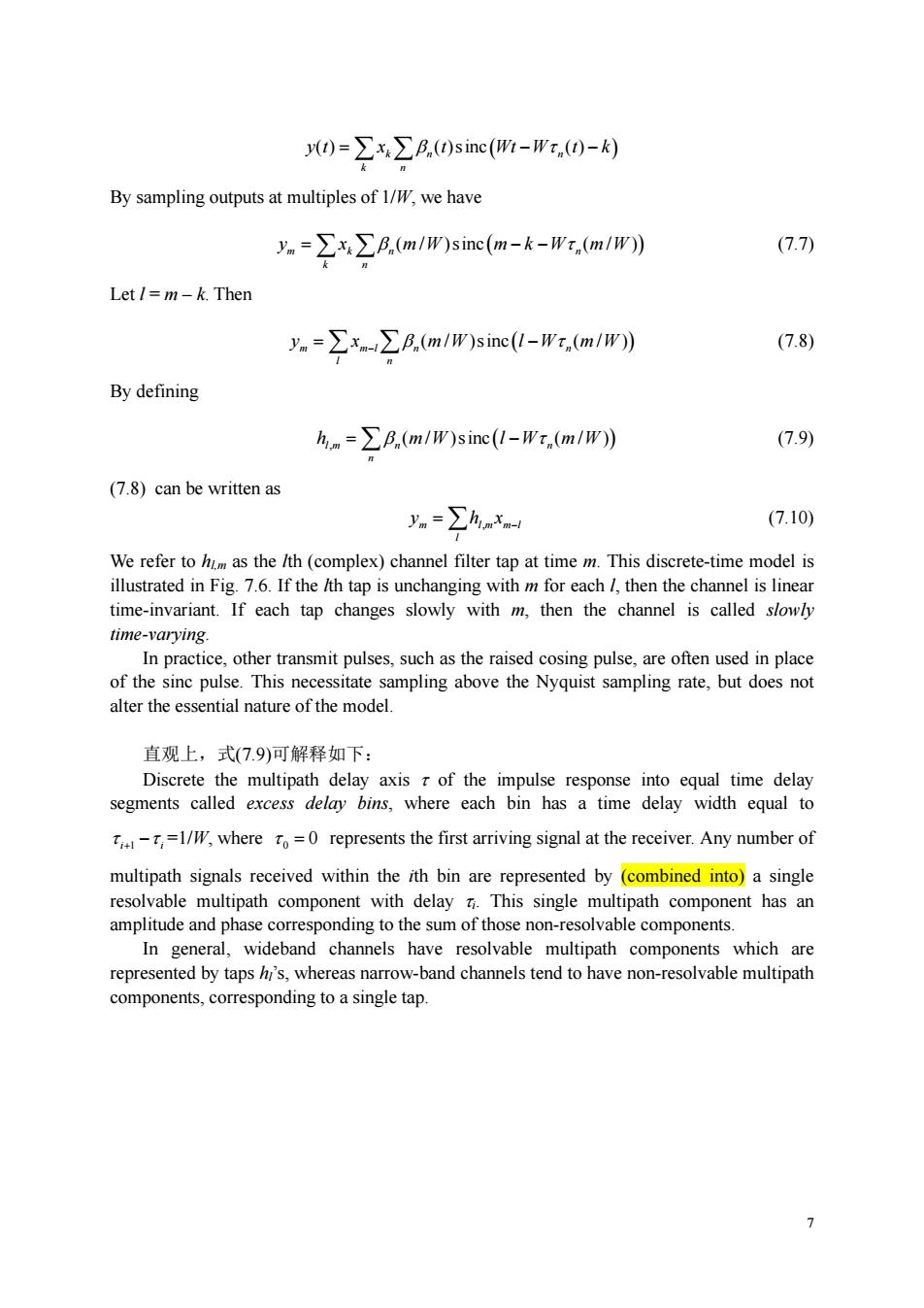
0=∑x∑B.(0sinc(W1-Wx()-k) By sampling outputs at multiples of 1/W,we have y=∑x∑B(m/W)sinc(m-k-Wx.(m/W) (7.7) Let/=m-k.Then y.=∑x-∑B,(m/W)sinc(-Wr,(m/W) (7.8) By defining h=B.(m/W)sinc(1-Wi(m/W)) (7.9) (7.8)can be written as yn=∑hnx (7.10) We refer tohm as the /th(complex)channel filter tap at time m.This discrete-time model is illustrated in Fig.7.6.If the th tap is unchanging with m for each /then the channel is linear time-invariant.If each tap changes slowly with m,then the channel is called slowly time-varying. In practice.other transmit pulses.such as the raised cosing pulse.are often used in place of the sinc pulse.This ne ate mpling above the Nyquist sampling rate,but does not alter the essential nature of the model. 直观上,式(7.9)可解释如下: Discrete the multipath delay axis r of the impulse response into equal time delay segments called excess delay bins,where each b in has a time delay width equal to ,=1/,where0represents the first arriving signal at the receiver.Any number of multipath signals received within the ith bin are represented by (combined into)a single resolvable multipath component with delay This single multipath component has an amplitude and phase corresponding to the sum of those non-resolvable components. In ge eral. widehand channels esolvable multipath components whichr represented by taps h's,whereas narrow-band channels tend to have non-resolvable multipath components,corresponding to a single tap. 7
7 ( ) ( )sinc ( ) kn n k n y t x t Wt W t k By sampling outputs at multiples of 1/W, we have m kn n ( / )sinc ( / ) k n y x mW m k W mW (7.7) Let l = m – k. Then m ml n n ( / )sinc ( / ) l n y x mW l W mW (7.8) By defining , ( / )sinc ( / ) lm n n n h mW l W mW (7.9) (7.8) can be written as m lm m l , l y h x (7.10) We refer to hl,m as the lth (complex) channel filter tap at time m. This discrete-time model is illustrated in Fig. 7.6. If the lth tap is unchanging with m for each l, then the channel is linear time-invariant. If each tap changes slowly with m, then the channel is called slowly time-varying. In practice, other transmit pulses, such as the raised cosing pulse, are often used in place of the sinc pulse. This necessitate sampling above the Nyquist sampling rate, but does not alter the essential nature of the model. 直观上,式(7.9)可解释如下: Discrete the multipath delay axis of the impulse response into equal time delay segments called excess delay bins, where each bin has a time delay width equal to i i 1 =1/W, where 0 0 represents the first arriving signal at the receiver. Any number of multipath signals received within the ith bin are represented by (combined into) a single resolvable multipath component with delay i. This single multipath component has an amplitude and phase corresponding to the sum of those non-resolvable components. In general, wideband channels have resolvable multipath components which are represented by taps hl’s, whereas narrow-band channels tend to have non-resolvable multipath components, corresponding to a single tap
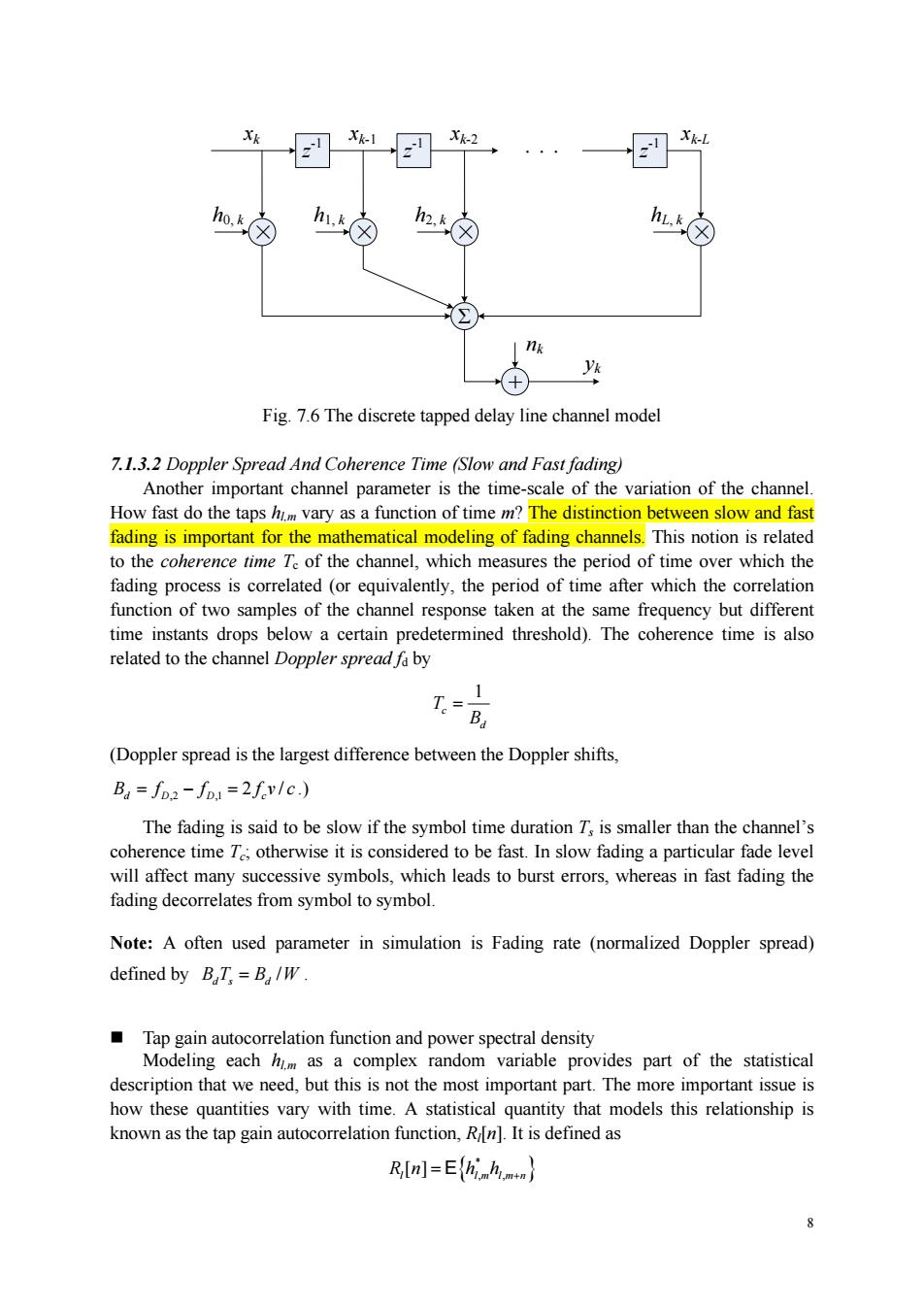
ho.k交 h⊙ ② Fig.7.6The discrete tapped delay line channel model 7.1.3.2 Doppler Spread And Coherence Time(Slow and Fast fading) Another important channel parameter is the time-scale of the variation of the channel How fast do the tapshm vary as a function of time m?The distinction between slow and fast fading is mportant for the mather modeling of fading channels.This notion is related to the coherence rime Tof the channel,which measures the period of time over which the fading process is correlated (or equivalently,the period of time after which the correlation function of two samples of the channel response taken at the same frequency but different time instants drops below a certain predetermined threshold).The coherence time is also related to the channel Doppler spread faby T.Ba (Doppler spread is the largest difference between the Doppler shifts, B,=f2-f1=2fv/c.) The fading is said to be slow if the symbol time duration T,is smaller than the channel's coherence time Totherwise it is considered to be fast.In slow fading a particular fade level will affect many successive symbols,which leads to burst errors,whereas in fast fading the fading decorrelates from symbol to symbol. Note:A often used parameter in simulation is Fading rate (normalized Doppler spread) defined by BT,=B/W. orrelation function and power spectral description that we need,but this is not the most important part.The more important issue is how these quantities vary with time.A statistical quantity that models this relationship is known as the tap gain autocorrelation function,R.It is defined as RL川=Ehhn}
8 z -1 z -1 z -1 × × × × Σ xk xk-1 xk-2 xk-L nk yk h0, k h1, k h2, k hL, k . . . Fig. 7.6 The discrete tapped delay line channel model 7.1.3.2 Doppler Spread And Coherence Time (Slow and Fast fading) Another important channel parameter is the time-scale of the variation of the channel. How fast do the taps hl,m vary as a function of time m? The distinction between slow and fast fading is important for the mathematical modeling of fading channels. This notion is related to the coherence time Tc of the channel, which measures the period of time over which the fading process is correlated (or equivalently, the period of time after which the correlation function of two samples of the channel response taken at the same frequency but different time instants drops below a certain predetermined threshold). The coherence time is also related to the channel Doppler spread fd by 1 c d T B (Doppler spread is the largest difference between the Doppler shifts, ,2 ,1 2 / BdD D c f f fv c .) The fading is said to be slow if the symbol time duration Ts is smaller than the channel’s coherence time Tc; otherwise it is considered to be fast. In slow fading a particular fade level will affect many successive symbols, which leads to burst errors, whereas in fast fading the fading decorrelates from symbol to symbol. Note: A often used parameter in simulation is Fading rate (normalized Doppler spread) defined by / Bds d T BW . Tap gain autocorrelation function and power spectral density Modeling each hl,m as a complex random variable provides part of the statistical description that we need, but this is not the most important part. The more important issue is how these quantities vary with time. A statistical quantity that models this relationship is known as the tap gain autocorrelation function, Rl[n]. It is defined as * , , [ ] Rn h h l lm lm n E
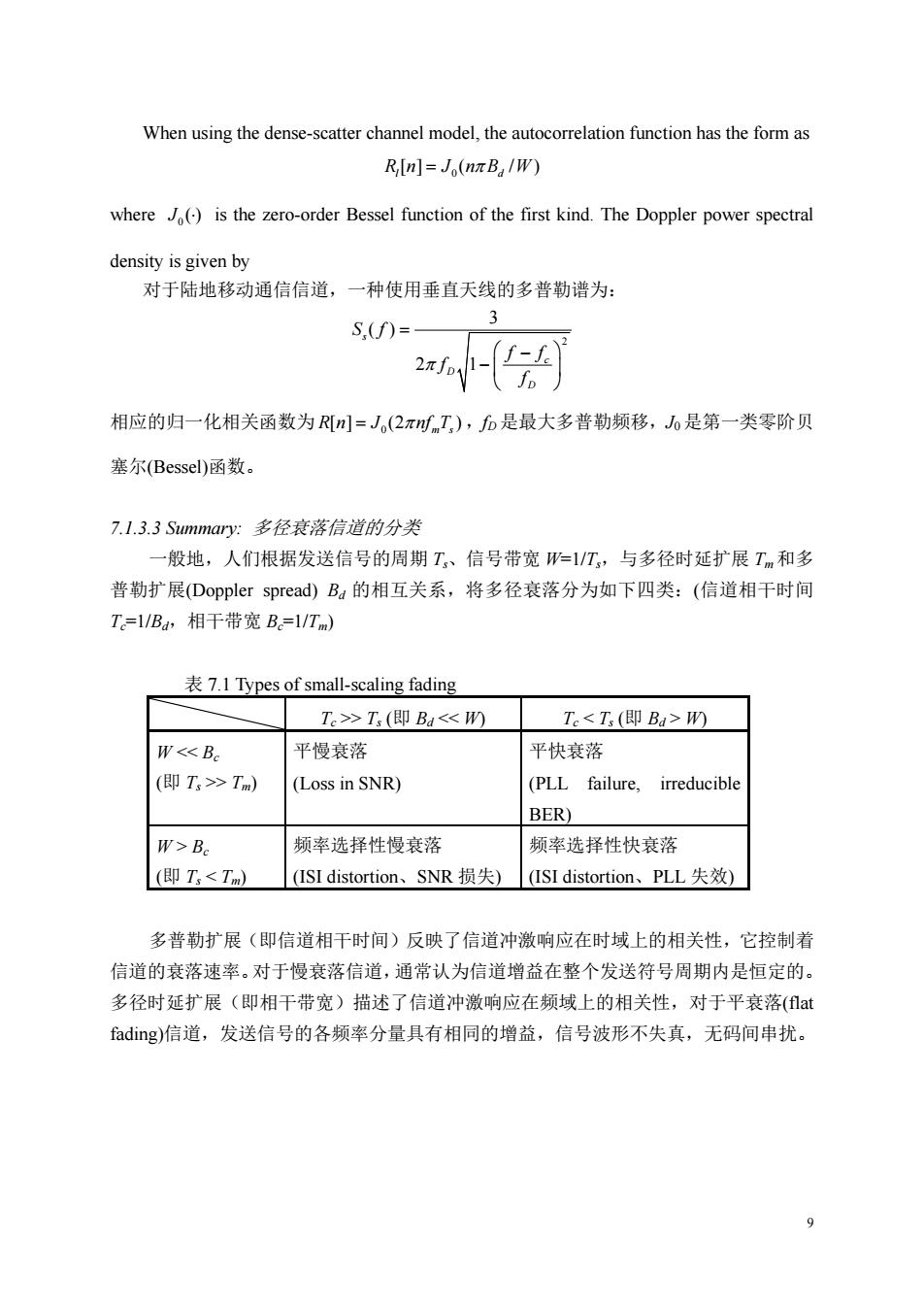
When using the dense-scatter channel model,the autocorrelation function has the form as RLm=J(nrB。/W) where)is the zero-order Bessel function of the first kind.The Doppler power spectral density is given by 对于陆地移动通信信道,一种使用垂直天线的多普勒谱为: S,(f)= 3 f-2 2xfoy-o) 相应的归一化相关函数为n=J。(2πT,),D是最大多普勒频移,6是第一类零阶贝 塞尔(Bessel)函数。 7.1.3.3 Summary:多径衰落信道的分类 一般地,人们根据发送信号的周期T,、信号带宽W=1/T,与多径时延扩展Tm和多 普勒扩展(Doppler spread)Ba的相互关系,将多径衰落分为如下四类:(信道相干时间 T=1/Ba,相干带宽B。=l/Tm) 7.1 Types of small-scaling fading Te>T(即Ba<m Te<T(即Ba> W<<B. 平慢衰落 平快衰落 (即T>Tm) Loss in SNR) (PLL failure,irreducibl BER) W>B. 频率选择性慢衰落 频率选择性快衰落 (即T,<Tm) (ISI distortion、SNR损失)(ISI distortion、PLL失效) 多普勒扩展(即信道相干时间)反映了信道冲激响应在时域上的相关性,它控制着 信道的衰落速率。对于慢衰落信道,通常认为信道增益在整个发送符号周期内是恒定的。 多径时延扩展(即相干带宽)描述了信道冲激响应在频域上的相关性,对于平衰落(lt fading)信道,发送信号的各频率分量具有相同的增益,信号波形不失真,无码间串扰
9 When using the dense-scatter channel model, the autocorrelation function has the form as 0 [] ( / ) Rl d n J nB W where 0 J ( ) is the zero-order Bessel function of the first kind. The Doppler power spectral density is given by 对于陆地移动通信信道,一种使用垂直天线的多普勒谱为: 2 3 ( ) 2 1 s c D D S f f f f f 相应的归一化相关函数为 0 [ ] (2 ) R m s n J nf T ,fD是最大多普勒频移,J0 是第一类零阶贝 塞尔(Bessel)函数。 7.1.3.3 Summary: 多径衰落信道的分类 一般地,人们根据发送信号的周期 Ts、信号带宽 W=1/Ts,与多径时延扩展 Tm和多 普勒扩展(Doppler spread) Bd 的相互关系,将多径衰落分为如下四类:(信道相干时间 Tc=1/Bd,相干带宽 Bc=1/Tm) 表 7.1 Types of small-scaling fading Tc >> Ts (即 Bd << W) Tc < Ts (即 Bd > W) W << Bc (即 Ts >> Tm) 平慢衰落 (Loss in SNR) 平快衰落 (PLL failure, irreducible BER) W > Bc (即 Ts < Tm) 频率选择性慢衰落 (ISI distortion、SNR 损失) 频率选择性快衰落 (ISI distortion、PLL 失效) 多普勒扩展(即信道相干时间)反映了信道冲激响应在时域上的相关性,它控制着 信道的衰落速率。对于慢衰落信道,通常认为信道增益在整个发送符号周期内是恒定的。 多径时延扩展(即相干带宽)描述了信道冲激响应在频域上的相关性,对于平衰落(flat fading)信道,发送信号的各频率分量具有相同的增益,信号波形不失真,无码间串扰
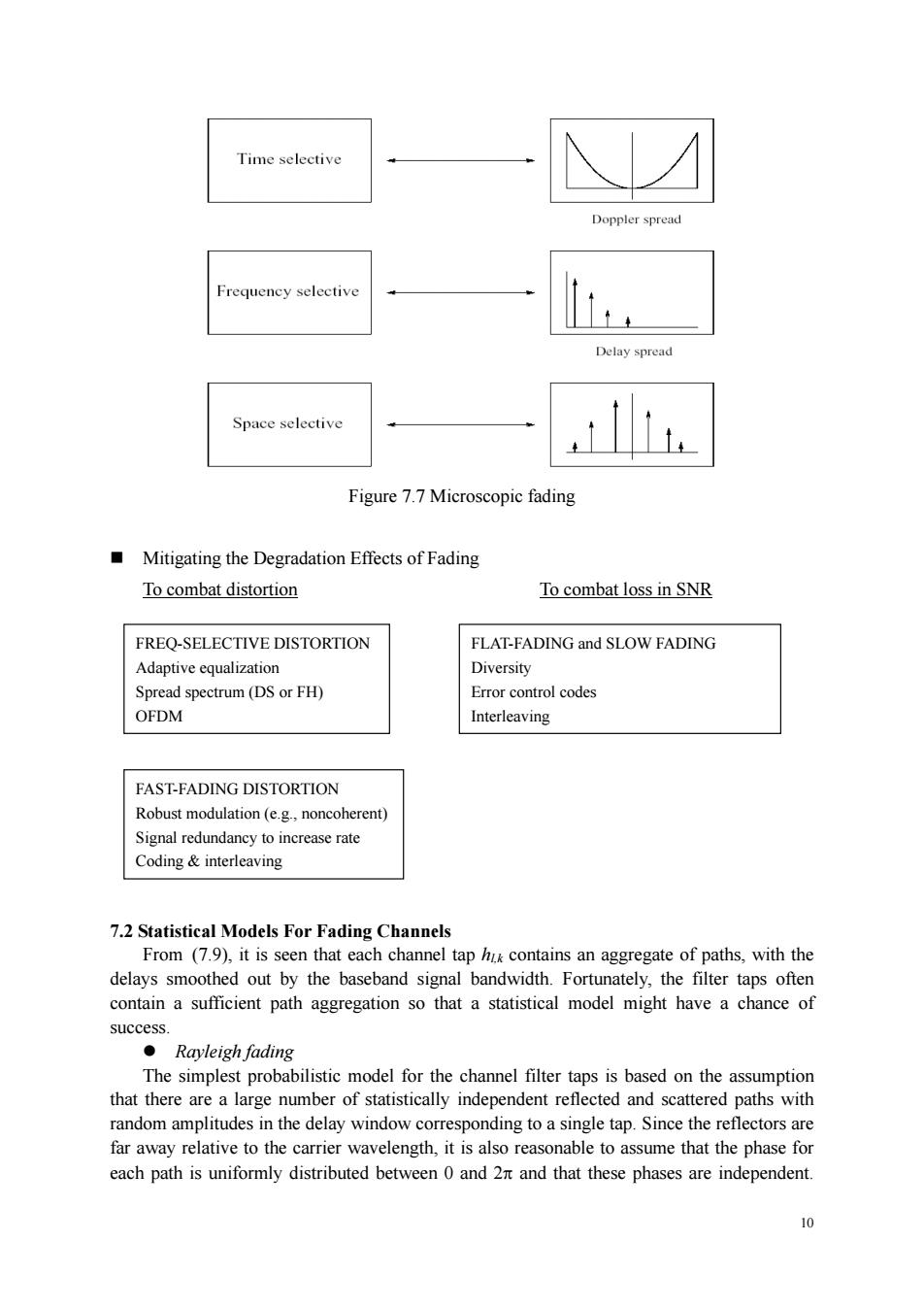
Time selectiv Doppler sprea Frequency selective Delay spread Space selective Figure 7.7 Microscopic fading Mitigating the Degradation Effects of Fading To combat distortion To combat loss in SNR FREO-SELECTIVE DISTORTION FLAT-FADING and SLOW FADING Adaptive equalization Diversity ead spectrum(DS or FH) Error control codes OFDM Interleaving FAST-FADING DISTORTION Signal undancy to ncrease rat 7.2 Statistical Models For Fading Channels From (7.9),it is seen that each channel tap h contains an aggregate of paths,with the delays smoothed out by the baseband signal bandwidth.Fortunately,the filter taps often contain a sufficient path aggregation so that a statistical model might have a chance of ●Rayleigh fading The simplest probabilistic model for the channel filter taps is based on the assumption that there are a large number of statistically independent reflected and scattered paths with oapntudes in the delay window corresponding to a single tap.Since the renec far away relative to the carrie onable to ass ume that the phase for each path is uniformly distributed between 0 and 2 and that these phases are independent
10 Figure 7.7 Microscopic fading Mitigating the Degradation Effects of Fading To combat distortion To combat loss in SNR 7.2 Statistical Models For Fading Channels From (7.9), it is seen that each channel tap hl,k contains an aggregate of paths, with the delays smoothed out by the baseband signal bandwidth. Fortunately, the filter taps often contain a sufficient path aggregation so that a statistical model might have a chance of success. Rayleigh fading The simplest probabilistic model for the channel filter taps is based on the assumption that there are a large number of statistically independent reflected and scattered paths with random amplitudes in the delay window corresponding to a single tap. Since the reflectors are far away relative to the carrier wavelength, it is also reasonable to assume that the phase for each path is uniformly distributed between 0 and 2 and that these phases are independent. FREQ-SELECTIVE DISTORTION Adaptive equalization Spread spectrum (DS or FH) OFDM FLAT-FADING and SLOW FADING Diversity Error control codes Interleaving FAST-FADING DISTORTION Robust modulation (e.g., noncoherent) Signal redundancy to increase rate Coding & interleaving